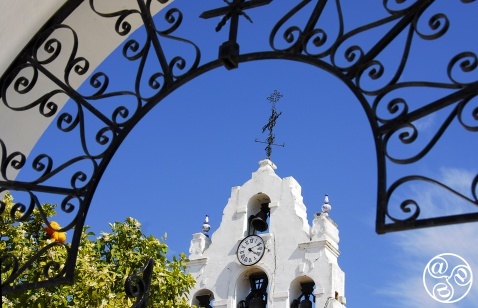
The Sanctuario de Nuestra Señora Virgen de la Cinta, a chapel where Columbus is said to have prayed before setting sail. |
|
Huelva's attraction for successive generations of settlers lies in its geographical position on a large river estuary, on the Atlantic coast, and its proximity to rich mineral deposits. Its origins can be traced back to prehistoric times, when the first settlers in the Bronze Age were drawn to the area by the minerals in the area that is now the site of the Río Tinto mines.
In the 7th century BC Phoenician and Greek merchants established a trading settlement and port in Huelva and exported the minerals they found throughout the Mediterranean. The Phoenician and Greek influence on western Andalucía around this time is known as Tartessian culture, which had an important base in Huelva.
Tartessus was described by writers much later as a mythical place of great wealth, which some believed was located where Huelva stands today. (Others argue it was either in the area now the Coto Doñana, Seville or Cadiz, among other places). Tartessian archaeological finds are displayed in the city's museum, the Museo de Huelva. Four Tartessian burial mounds have been discovered in the Parque Moret in the north of the city.
The Romans expanded the port for exporting their minerals, mainly copper and silver extracted from the Río Tinto mines, to other places in their vast empire. They renamed Huelva Onuba Æstuaria and the city's inhabitants are still called onubenses today. Underneath the ridge of hills known as the Cabezos, in the Conquero area to the west of the Parque Moret, are the remains of a Roman aqueduct dating from the 1st century AD.
Under the Moors, Huelva was known as Ghelbah. They used the port as a trading post for commerce with northern Africa. Their imprint on today's city can be glimpsed in religious architecture like that of the Iglesia de San Pedro, although most of Huelva's Moorish inheritance was destroyed in the 1755 Lisbon earthquake.
After the Reconquest, when Alfonso X recaptured Huelva from the Moors, it came under the control of the kingdom of Seville, followed by the dukes of Medina Sidonia. By the 15th century, Huelva was established as a significant port, but it was not until 1492 when Christopher Columbus discovered the New World that it gained in status.
Columbus used local sailors for his historic voyage and the increase in trade brought wealth to the whole region, although it was later superceded by the ports of Seville and Cadiz. Huelva's pride in its links with Columbus can be seen today, with streets and monuments named after Columbus and the mariners who sailed with him and its restoration of the Sanctuario de Nuestra Señora Virgen de la Cinta, a chapel where Columbus is said to have prayed before setting sail.
Huelva was declared provincial capital in 1833 and by the end of the 19th century was undergoing a massive transformation with the influx of foreign capital from mining interests. Its main function as a maritime port became secondary to its industrial importance as mining activities grew, based on the exploitation of the Río Tinto mines by the Río Tinto Company and five other British mining firms.
The mining companies changed the architectural face of Huelva, building industrial structures like the wharfs in the port used for unloading minerals, workshops and the railway. Culturally, Huelva underwent a revival and cultivated a more cosmopolitan atmosphere with the arrival of mainly British and German workers. This was a time of great surplus wealth, which was lavished on elegant edifices in the centre, such as the Gran Teatro with its French-influenced architecture, the Casa Colón, the Círculo Mercantil on Calle Rico just south of the Plaza de las Monjas, and the former Conservatorio de Música, now the Clínica Sanz de Frutos, on the same street.
The legacy of late 19th-century British architecture still standing today includes the Muelle de Ríotinto, the Estación de Sevilla, the Barrio Obrero and the Casa Colón. One of the main streets in the centre is named after the German businessman, Wilhem Sundheim, who was instrumental in the takeover of the Río Tinto mines by a British consortium.
In the Cementario de la Soledad is the body of William Martin, a supposed naval commander, known as 'the man who never existed'. During the Second World War, the Allies wanted to distract German intelligence from their planned landing in Sicily, ready for the invasion of Italy, by pretending that a similar landing would be taking place elsewhere. The corpse of 'William Martin' was discovered by a fisherman on the beach of El Portil, near Huelva, and had documents on him hinting at a supposed Allied landing in Sardinia or Greece. The Allies' hope that the German spies operating in Huelva at the time would believe the information and send it back to Germany was successful.
Since the 1950s most of Huelva's wealth has come from its flourishing petrochemical industry, established by Franco.